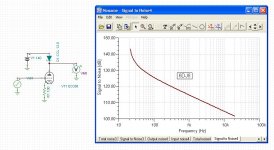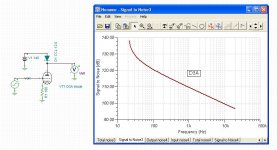Some progress has been made in being able to predict flicker (1/f) noise in vacuum tubes:
IEEE Xplore Abstract - On the Electrical Origin of Flicker Noise in Vacuum Devices
I'm not going to pay for the article, sorry.
IEEE Xplore Abstract - On the Electrical Origin of Flicker Noise in Vacuum Devices
I'm not going to pay for the article, sorry.
Hi,
While I haven't read Vogel's analysis, is it worthwhile to pick a tube (triode or penthode) with a known low Req (as per the datasheet that is)or is this just a waste of time and is one better of just selecting a given tube (say a 6DJ8) for low noise at AF and take it from there?
Plus, how important is the role of Gm in noise performance?
TIA, 😉
That's why you need to compare your predictions to reality. Those "simple" mathematical functions don't correspond to real pieces of glass and metal. For example, 2.5/gm only works at RF and absolutely ignores the 1/f noise corner. See Blencowe's paper, as well as Vogel's analysis in his book and in his recent Linear Audio paper.
While I haven't read Vogel's analysis, is it worthwhile to pick a tube (triode or penthode) with a known low Req (as per the datasheet that is)or is this just a waste of time and is one better of just selecting a given tube (say a 6DJ8) for low noise at AF and take it from there?
Plus, how important is the role of Gm in noise performance?
TIA, 😉
Plus, how important is the role of Gm in noise performance?
One generally follows the other, but only generally. There's also a minimum with current, i.e., more current (higher gm) does not necessarily result in lower noise and there's actually an optimum current (so much for 2.5/gm!). Merlin found that lower gm tubes are more critical in this respect, but even higher gm tubes showed a broad minimum well below the point where gm vs. current levels off.
Obviously Tina does in fact use some kind of mathematical formula to predict vacuum tube noise. Otherwise, the noise would be the same for the 6DJ8 and D3A triode since ALL other circuit elements are the same for each measurement.
While I do not believe the absolute value of the prediction, it is merely a guide for me to choose which one is most likely to be better.
While I do not believe the absolute value of the prediction, it is merely a guide for me to choose which one is most likely to be better.
Attachments
One generally follows the other, but only generally. There's also a minimum with current, i.e., more current (higher gm) does not necessarily result in lower noise and there's actually an optimum current (so much for 2.5/gm!). Merlin found that lower gm tubes are more critical in this respect, but even higher gm tubes showed a broad minimum well below the point where gm vs. current levels off.
Flicker (1/f) noise is proportional to plate current (or more precisely, cathode heating (ie temperature)), so I think it's obvious that increasing current does not necessarily reduce noise, since both Gm and Rp vary with plate current. Most likely, there is an optimum point in the plate current vs. Gm, Rp and 1/f noise curves and that is merely what he is determining. I'm sure you're enough of a software maven to create a 3D surface map that would show the optimum point of lowest noise for any particular tube.
Actually, as I recall, flicker noise is a bell curve in relationship to cathode temperature. So, it's not exactly proportional. Sorry!
Last edited:
I know this is an old thread, but a have a couple of Electra Print 100H 30mA Anode cokes to load a E280F in triode > 0.2uF capacitor >300B grid, and wonder what inductance would suit the 300B grid if a grid transformer was used ?
- Status
- Not open for further replies.
- Home
- Amplifiers
- Tubes / Valves
- Grid Chokes and choke load

